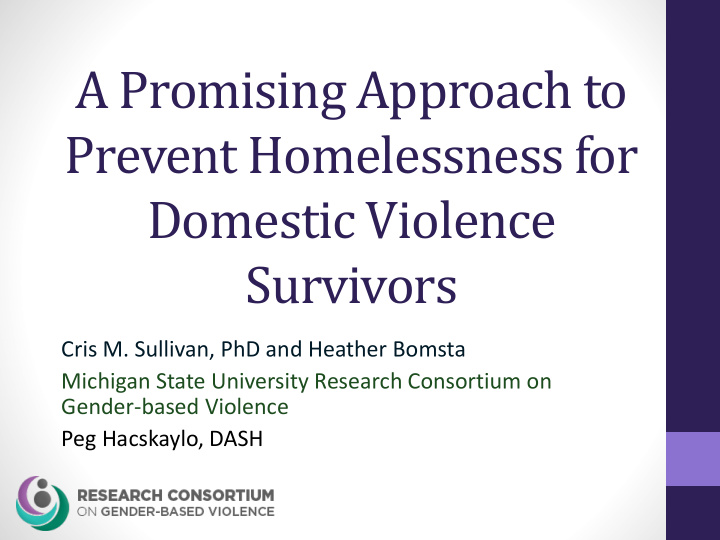



A Promising Approach to Prevent Homelessness for Domestic Violence Survivors Cris M. Sullivan, PhD and Heather Bomsta Michigan State University Research Consortium on Gender-based Violence Peg Hacskaylo, DASH
The Problem Housing instability is 4x more likely for women who have experienced domestic violence
The Problem One in four homeless women cite domestic violence as a major contributor to their homelessness
The Problem Of homeless women with children, over 80% have experienced domestic violence
The Problem • Pathways from DV to homelessness are both direct and indirect: • Many abusers intentionally destroy victims’ financial stability by ruining their credit, harassing them at their jobs, preventing them from working or going to school, stealing from them…
The Problem • Indirect pathways include: • DV often leads to injuries, PTSD, depression, all of which can lead to job instability and housing instability • Many women leave their homes to protect their children, but then can not afford to support them
Innovative Responses • “Domestic Violence Housing First” is a model using intensive, mobile advocacy and flexible funding to help survivors obtain safe and stable housing • “Flexible funding” with brief advocacy is being examined as a way to prevent homeless from occurring
Why Flexible Funding? Some survivors can avoid homelessness if they have access to immediate funds , coupled with housing advocacy and support. International aid studies have shown that direct funds to those in need have immediate and long term positive impacts.
Does Flexible Funding Work? • Evaluated an innovative program in Washington, DC • DASH – District Alliance for Safe Housing
DASH Provides a Range of Services: A 43-unit apartment- style “shelter” A transitional-to-permanent scattered site safe housing program Housing Resource Center: A variety of homeless prevention services through: Advocacy The Survivor Resilience Fund ( a flexible funding program ), where grants are given to help survivors attain stable, safe housing
Guiding Principles in Flexible Funding Decisions “Can any other organization provide this resource?” “Will this grant help this person to retain housing, not just today, but over time ?” Process is survivor-centered, accessible, and respectful Process is quick to respond to urgent situations
Research Plan Survivors invited to participate when applying for grant Interviewed at 30-days, 3-months and 6-months post-grant 55 survivors in study 95% retention rate at three months 87% retention at six months
Demographics 53 women, 2 men Average age 34 (range 21-57 years old) Primarily African American 82% have children (range 0-4)
Amount of Flex Funding Awarded Average grant: $2,078 Grant range: $275 - $8,508 Grants were used for: Utilities Moving expenses Car repair Back rent Child care Credit card debt Storage unit fees Out-of-state travel to Other needs court for custody hearing
Housing at Six Months Follow-up 94% housed Up-to-date Somewhat No way to Homeless on rent behind on pay next rent month’s rent 37 (76%) 6 (12%) 3 (6%) 3 (6%)
The Process of Receiving the Grant was Important to Survivors Process was: Low barrier FAST Caring and non- judgmental
Low Barrier "When I went to DASH they were more willing to listen to my story, ask some questions, ‘OK, we can help you.’ And that was it. It wasn’t like ‘OK, we need you to join our program. We need you to sit down. We need you to come in everyday. We need you to come in… ' It wasn’t like that. I didn’t feel like … I didn’t feel like somebody put a gun to my head – I mean to, you know, receive help .”
FAST “I expected to be there for hours. I had brought as much information that I could possibly find because I just assumed that it would be a long day there and it would be a million and one questions, but it was totally the opposite. It was totally the opposite and it was very refreshing.”
Caring & Non-judgmental “Usually you talk to someone like that [a service provider] and it’s more like, ‘oh, I would’ve did this’ or ‘I would’ve did that.’ And, you know, it wasn’t like that. It was more like they understood. …I didn’t have to hear, ‘oh, well , why didn’t you leave?’ or – you know. I didn’t get that from them.”
Children’s Well -being “[My daughter] used to be kind of violent with her doll babies and, you know, having tantrums, slamming doors. And now it’s more relaxed so she’s She’s not ripping doll more calm with her babies' heads off.” doll babies.
Impact on Well-being Midway through the evaluation, we started asking at 6 months (n=31): Thinking back over the last 6 months, when you went to DASH for funds… would you say that, overall your life is better off, worse off, or no different: ☐ Better off ☐ Worse off ☐ No different 100% felt “better off” And would you say you are more hopeful about the future than you were then? Less hopeful? Or no change? 90% felt “more hopeful” More hopeful
Impact on Safety We later began asking survivors in 6 month interviews if they had experienced any domestic violence since receiving their flexible funding Of the 23 survivors asked the question: 20 (91%) reported no further DV 1 reported receiving harassing phone calls 2 experienced further DV
The Promise of Flexible Funding Flex funding with brief advocacy is promising option for some survivors Those who were relatively stable, and are now experiencing a crisis Flex funding with longer-term advocacy (DV Housing First, DV Rapid Re-housing) is also promising, needs further research
Next Steps Identify where else this is happening; replicate Some government agencies looking at how to provide more of this type of funding and service, as it appears effective and cost- effective
Recommend
More recommend